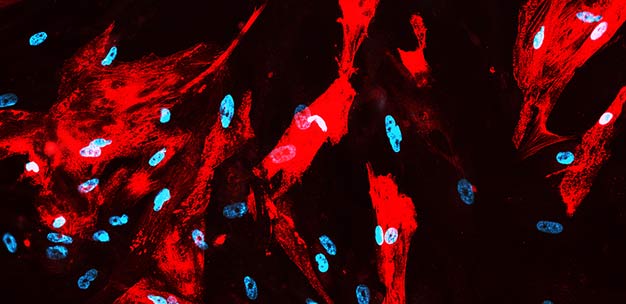A small RNA molecule can convert fibroblast cells directly into beating heart muscle cells
Published online 17 December 2015

Human heart muscle cells (red) generated from fibroblasts by direct reprogramming.
© 2014 WILEY-VCH Verlag GmbH & Co. KGaA, Weinheim
Keio researchers have found a direct and efficient way to convert mature cells from one type to another. The technique could eventually be used to stimulate a patient's connective tissue cells to become the beating heart muscle cells that will repair their damaged hearts.
"Heart failure is the number two killer in Japan," says Masaki Ieda at Keio University School of Medicine, who led the study. And cardiovascular diseases remain the leading cause of death worldwide, affecting an estimated 17.5 million people annually.
Many research groups are trying to create mature cell types that could be used in regenerative medicine, but mostly via the stem cells route. Ieda and his co-workers are world leaders in exploring an alternative, direct path. In 2010, they were among the first groups to report direct reprogramming, when working with neurons and cardiac cells1.
"Direct reprogramming is faster and simpler than stem-cell-based methods and carries no risk of tumor formation," says Ieda.
In their most recent study, Ieda and his colleagues, in collaboration with other Japanese research centers, found an efficient way to convert connective tissue cells known as fibroblasts into beating heart muscle cells called cardiomyocytes2.
The researchers found that a small RNA molecule known as miR-133 can repress the activity of a key regulatory gene in a way that promotes the desired reprogramming into cardiomyocytes1. The miR-133 molecule is one of many microRNAs that can silence gene activity by binding to the larger messenger RNA molecules that carry genetic information from DNA to be decoded into active proteins. Overall, the miR-133 molecules block the activity of a large set of genes that make cells fibroblasts, while at the same time allowing other sets of genes that generate cardiac cells to become active.
Uncovering this fine detail about the mechanism by which fibroblasts can be reprogrammed into heart muscle cells should greatly assist efforts to move the current exploratory studies into real treatments. While Ieda used cultured cells in his study, he believes that similar techniques might eventually be possible in human patients. "We think we could reprogram fibroblasts into beating heart cells in situ," says Ieda.
Ieda now plans to explore ways to make the reprogramming process more efficient. In addition to the ultimate aim of repairing beating hearts, this work could also generate cells that can be used for modeling heart disease and testing potential new drugs.
References
- Ieda, M., Fu, J.-D., Delgado-Olguin, P., Vedantham, V., Hayashi, Y., Bruneau, B. G. & Srivastava, D. Direct reprogramming of fibroblasts into functional cardiomyocytes by defined factors. Cell 142, 375-386 (2010). | article
- Muraoka, N. et al. MiR‐133 promotes cardiac reprogramming by directly repressing Snai1 and silencing fibroblast signatures. The EMBO Journal 33, 1565-1581 (2014). | article